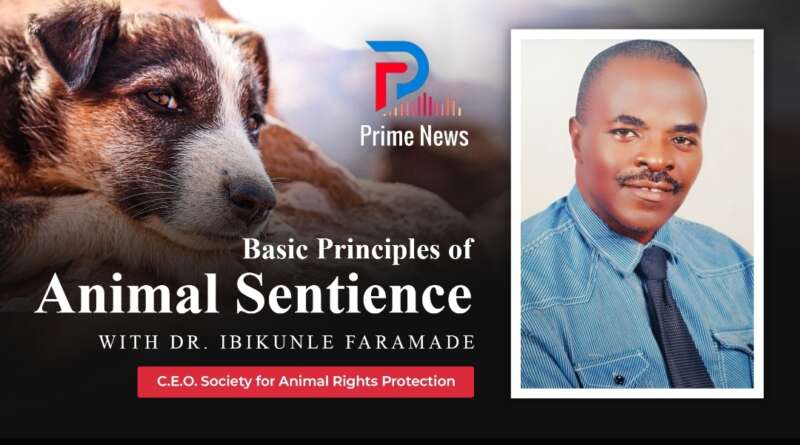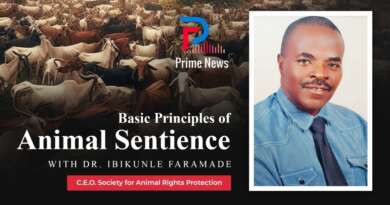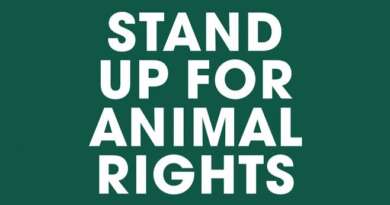Basic Principles of Animal Sentience and Welfare
By Dr. Ibikunle Faramade
According to the World Organization for Animal Health, WOAH, Animal welfare could be defined as the physical and mental states of an animal in relation to the conditions in which it lives or dies (OIE, 2019). The expression “bien-etre animal was introduced in France in the 1980 from the English word “welfare ” which covers both the well-being of an individual (Health, Comfort, etc.) and its protection, in other words, the measures defined by legislation to guarantee its welfare. Most authors agree on the principle that welfare is both a state of physical health, represented by the absence of injury or illness, and of mental health, covering the absence of prolonged negative emotions and search for positive emotions.
In the OIE Terrestrial Animal Health Code, animal welfare means “how an animal is coping with the conditions in which it lives. An animal is in a good state of welfare if (as indicated by scientific evidence) it is healthy, comfortable, well nourished, safe, able to express innate behavior, and if it is not suffering from unpleasant states such as pain, fear and distress. Good animal welfare requires disease prevention and veterinary treatment, appropriate shelter, management, nutrition, humane handling and humane slaughter/killing. The treatment that an animal receives is covered by other terms such as animal care, animal husbandry, and humane treatment.
The concept of animal welfare took its root from the consensus of most of the ancient philosophers such as Plutarch, Hippocrates and Pythagoras among others who averred animals deserve fair treatment. Their conclusions were based on their knowledge that animals have the capacity to feel pain and suffer. The opinion of a few dissenting philosophers such as Descartes, who saw animals as ‘automata’ incapable of feeling or suffering was overshadowed by the intellectual fecundity of the 18th century heralding the age of enlightenment. This position was promoted by Charles Darwin stating that animals have similar characteristics like humans. Dr. Bernard Rollin, a University of Colorado State University aptly stated in 2003 that the neural mechanisms responsible for pain behavior are greatly similar in all vertebrates.
The capacity of animals to feel pain could be seen when they avoid the use injured limb by limping, their cries e.g. the screams of castrated or docked piglets, change in mood, unresponsiveness, et c. Facial expressions also have the potential to indicate psychological and emotional experiences of animals and could provide information on temporal or stimuli specific reactions. Repeated or prolonged stressful conditions could cause illness and sufferings in animals. This could be in form of development of stomach ulcers, reduced fertility, heart diseases, immunosuppression and increased mortality. Animals should be protected from fear, anxiety and stress.
On the basis of the philosophical positions of the ancient time, Richard Martins in 1822 was credited as the first person to secure the prevention of cruelty against animal (cattle) through a legislation titled “An Act to prevent the cruel and improper Treatment of Cattle,” in the United Kingdom. This effort later led to the formation of the Society for the Prevention of Animal Cruelty in 1824. It was on this basis that other legislations in the UK and later in the United States of America and other countries were based. This later led to the adoption of Universal Declaration of Animal Right by the United Nation in 1978 of which many countries, including Nigeria are signatories. Animals have acquired a legal status as sentient beings in both European law (Treaty of Lisbon, 2007) and French law (“sensibilité del’animal enshrined in the French Civil Code via Law No. 2015-177 of 16 February 2015). Animal protection now concerns all animals whose lives are dependent on humans (pets, laboratory animals, farm animals, zoo animals).
The suffering of farm animals was brought to the front burner in the 1960s through a book authored by Ruth Harrison entitled ‘Animal Machines’. The book as an exposure of the harsh realities obtainable in intensive farming system. This compelled the Government of the United Kingdom to constitute a special committee on animal welfare in 1965. This was known as the Brambell Committee on Animal Welfare. The outcome of this committee’s effort is summarized as the five freedom of animals that should be guaranteed at all times. These include:
- Freedom from hunger and thirst: by ready access to fresh water and a diet designed to maintain full health and vigour;
- Freedom from discomfort: by the provision of an appropriate environment including shelter and a comfortable resting area;
- Freedom from pain, injury and diseases: by prevention or through rapid diagnosis and treatment;
- Freedom to express normal behavior: by the provision of sufficient space, proper facilities and company of the animal’s own kind; and
- Freedom from fear and distress: by the assurance of conditions that avoid mental suffering.
The United Nations Declaration on animal Rights 1978 is as follows:
Universal declaration of animal rights was solemnly proclaimed in Parison 15 October 1978 at the UNESCO headquarters
Preamble:
- Whereas all animals have rights;
- Whereas disregard and contempt for the rights of animals have resulted and continue to result in crimes by man against nature and against animals;
- Whereas recognition by the human species of the right to existence of other animal species is the foundation of the co-existence of species throughout the animal world;
- Whereas genocide has been perpetrated by man on animals and the threat of genocide continues;
- Whereas respect for animals is linked to the respect of man for men;
- Whereas from childhood man should be taught to observe, understand, respect and love animals;
It is hereby proclaimed:
Article 1
All animals are born with an equal claim on life and the same rights to existence.
Article 2
- All animals are entitled to respect.
- Man as an animal species shall not arrogate to himself the right to exterminate or inhumanely exploit other animals. It is his duty to use his knowledge for the welfare of animals.
- All animals have the right to the attention, care and protection of man.
Article 3
- No animal shall be ill-treated or shall be subject to cruel acts.
- If an animal has to be killed, this must be instantaneous and without distress.
Article 4
- All wild animals have the right to liberty in their natural environment, whether land, air or water, and should be allowed to procreate.
- Deprivation of freedom, even for educational purposes, is an infringement of this right.
Article 5
- Animals of species living traditionally in a human environment have the right to live and grow at the rhythm and under the condition of life and freedom peculiar to their species.
- Any interference by man with this rhythm or these conditions for purposes of gain is an Infringement of this right.
Article 6
- All companion animals have the right to complete their natural lifespan.
- Abandonment of an animal is a cruel and degrading act.
Article 7
- All working animals are entitled to a reasonable limitation of the duration and intensity of their work, to the necessary nourishment, and to rest. Animal experimentation involving physical or psychological suffering is incompatible with the rights of animals whether it be for scientific, medical, commercial, or any other form of research.
- Replacement methods must be used and developed.
Article 8
Where animals are used in the food industry, they shall be reared, transported, lairaged and killed without the infliction of suffering.
Article 9
- No animal shall be exploited for the amusement of man
- Exhibitions and spectacles involving animals are incompatible with their dignity.
Article 10
Any act involving the wanton killing of an animal is biocide, that is, a crime against life.
Article 11
- Any act involving mass killing of wild animals is genocide, that is, a crime against the species.
- Pollution or destruction of the natural environment leads to genocide.
Article 12
- Dead animals shall be treated with respect.
- Scenes of violence involving animals shall be banned from cinema and television,
- Except for humane education.
Article 13
- Representatives of movements that defend animal rights should have an effective voice at all levels of government.
- The rights of animals, like human rights, should enjoy the protection of law. The Universal Declaration of Animal Rights was solemnly proclaimed in Paris on 15 October 1978 at the UNESCO headquarters.
Animal Welfare Law in Nigeria
While Nigeria does not have stand-alone legislation regarding animal welfare, the Nigeria criminal codes does include many prohibition regarding animal cruelty, and the wording suggests some acknowledgement that animal can suffer both physically and mentally. The African Union Inter- African Bureau for Animal Resources (AU- IBAR) developed Animal Welfare strategy for Africa (AWSA) in 2016 and this document forms the basis of revision to legislation. Similarly, the criminal Code (1990), provides specific protection for some categories of animals, such as those used for draught purpose for whom it is prohibited to overload or overwork, and a national ban on animal fights.The Animal Disease Control Act (2022) provides some additional protections for farm animals including limiting stocking density during transportation to ensure adequate ventilation. During transportation of animal for the purpose of slaughter, it was stated that the journey may not exceed thirty kilometers and that transport of animals for trade by road requires the transporter to stop to feed, water and rest the animal every twelve hours. Loading ramps are also expected, to be provided to reduce injury.
In conclusion, the understanding that animals are sentient beings is the basis upon which animal welfare considerations are based. While it is true that it is difficult to state exactly how animals perceive pain and sufferings, it is beyond doubt that animals do feel pain, show emotion and are well conscious of their environment and that over time they have developed skills to cope with their environments, the distortion of which impose a burden of stressors upon them.
Humanity should therefore, respect the boundaries between humans and animals by according them fair consideration in our dealings with them.
Dr. Ibikunle Faramade is veterinary pathologist and a lecturer at the Federal College of Animal Health and Production Technology, Apata, Ibadan. He’s the C. E. O of the Society for Animal Rights Protection, a non profit and a non governmental organization dedicated to the promotion of animal welfare, animal rights and prevention of cruelty to animals.
animalrightsprotection2020@gmail.com, +2348028305284




